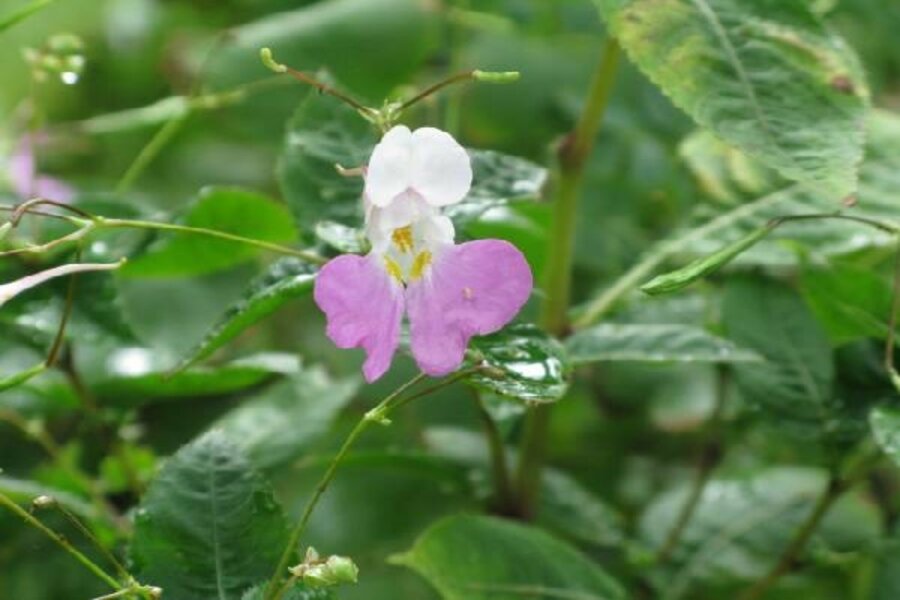A different kind of impatiens in the garden
Loading...
Who knew?
There is more to the world of impatiens than the ubiquitous six-pack of your favorite bedding annual available at every local nursery, garden center, and big box store nationwide.
I, for one, was pleasantly surprised when, at one glorious garden a few years back, I chanced upon a stand of the most interesting blooming plants I had seen in a long time. Growing in the shady section of the yard, the impressive plants, approximately three feet tall and almost as wide, sported interesting pink and white orchid-shaped blossoms above lush green foliage.
I was, to say the least, captivated.
So what were these plants for which I now lusted? They were Impatiens balfourii –. and I knew I just had to have some for my woodland garden.
A native of the Himalayas, Impatiens balfourii – also known as Balfour’s touch-me-not, Kashmir balsam, and poor man’s orchid – grows wild in mountains of 5,000 to 6,000 feet around Kashmir and surrounding areas.
Popular in England, they were originally introduced to the United States around the San Francisco Bay area, then to other parts of the nation -- and finally, to my garden as well. However, what is new to me apparently isn’t quite so new to many of our grandmothers who remember growing it in their backyards back in the 1950s.
I don’t understand why this vibrantly handsome and elegantly charming species is not more fashionable. Popular with insects and hummingbirds, the plants flower over a long period of time, and once they've been introduced into the garden, they seem to take on a life of their own, popping up in some of the most interesting of places.
Since they're prolific reseeders, I suppose they could become somewhat invasive – though it’s a simple task just to pull out those you don’t want. And unless your garden consists of nothing more than consistently moist soil in cool, dappled shade, I. balfourii should remain the highly welcomed, well-mannered and treasured rarity that it is in my garden.
Yes, Impatiens balfourii are hard to find and somewhat expensive, but purchasing those first few plants, I feel, is well worth the effort and expense.
The plant derives its botanical name Impatiens (Latin for “impatient”) and the common name “touch-me-not” from the plant’s seedpods. When these seedpods mature, they “explode’ when touched, sending seeds several feet in all directions.
If you have kids, or are regularly visited by children as I am, these spring-loaded pods induce peals of laughter and hours of fun, while at the same time helping Mother Nature disperse the seeds throughout the garden for future revelries.
Though Impatiens is a genus of about 900 to 1,000 species of flowering plants in the Balsaminaceae family, only a handful are readily available commercially. They include plants so breathtaking and novel to the gardening world that you would never guess they are first cousins to your familiar bedding plant impatiens.
While the common bedding types – actually Impatiens hybrids – are not hardy, there are a smattering of cold-hardy species that return year after year in gardens as cold as USDA Zone 5 (winter lows to -20 F., or -29C).
There’s no denying that our annual impatiens bedding plants offer multitudes of fanciful blooms and dazzling colors, but for something different and unique, you just can’t beat their less common, but fascinating, relatives.
Betty Earl, author of "In Search of Great Plants: The Insider’s Guide to the Best Plants in the Midwest," writes a regular column for Chicagoland Gardening Magazine and The Kankakee Journal and numerous articles for Small Gardens Magazine, American Nurseryman, Nature’s Garden, and Midwest Living Magazine, as well as other national magazines. She is a garden scout for Better Homes and Gardens and a regional representative for The Garden Conservancy.
Editor’s note: For more Monitor gardening, see our main gardening page and our RSS feed.
You may also want to visit Gardening With the Monitor on Flickr. Take part in the discussions and get answers to your gardening questions. If you join the group (it’s free), you can upload your garden photos and enter our next contest.





